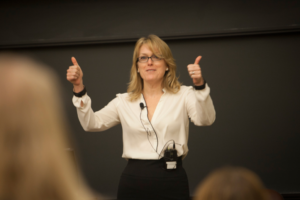Imagine the following scenario:
A school principal gathers wise cognitive scientists to ask a straightforward question…
“Because critical thinking is an essential 21st century skill, we know our students need to develop critical thinking skills. If we want to create a school program or a class or a curriculum to foster critical thinking, what guidance can you give us?”
Happily, we don’t have to imagine. At last week’s Learning and the Brain conference in New York, I asked a distinguished group of cognitive psychologists* exactly that question.
 The resulting conversation offered practical suggestions, provocative assertions, and a surprising amount of humor.
The resulting conversation offered practical suggestions, provocative assertions, and a surprising amount of humor.
I’ll try to summarize that half-hour conversation here.
On the One Hand…
Let’s start at one end of the spectrum, with the most optimistic ways to answer the question:
First: we know what critical thinking is.
Dr. Laura Portnoy, for instance, considers critical thinking the ability to support claims with evidence and reason.
If I claim that “the earth orbits the sun,” I should be able to cite evidence supporting that claim. And I should be able to explain the logical process I use to make conclusions based on that evidence.
Dr. Ben Motz agrees with that foundation, and adds an important step: critical thinkers recognize and avoid logical fallacies.
 A comprehensive list of logical fallacies goes on for pages, but critical thinkers typically question their own beliefs aggressively enough to avoid the most common mistakes.
A comprehensive list of logical fallacies goes on for pages, but critical thinkers typically question their own beliefs aggressively enough to avoid the most common mistakes.
Second: we know how to foster critical thinking.
The specifics of an answer probably vary by age and discipline. However, we’ve got specific curricular strategies to help us foster critical thinking among students.
Dr. Laura Cabrera, with this truth in mind, offers a specific bit of advice: start early.
If we want students to grow as critical thinkers, we shouldn’t wait until their sophomore year in high school. Kindergarten would be a fine place to start.
On the Other Hand…
All these optimistic answers, however, quickly give way to grittier – perhaps more realistic – assessments of the situation.
First: because critical thinking is so complicated, no precise definition holds true in a broadly useful way. In other words – politely speaking – we can’t exactly define it.
 In cognitive psychology terminology, as Dr. Derek Cabrera put it, “critical thinking has a construct validity problem.” In fact, the five psychologists on the panel – professors all – don’t agree on a definition.
In cognitive psychology terminology, as Dr. Derek Cabrera put it, “critical thinking has a construct validity problem.” In fact, the five psychologists on the panel – professors all – don’t agree on a definition.
Second: This definition problem has terrible implications.
If we can’t define critical thinking, broadly speaking, then we can’t determine a consistent way to measure it.
And if we can’t measure it, we have no (scientific) way of knowing if our “critical thinking program” helps students think critically.
Third: In fact, if we can’t measure students’ critical thinking skills right now, we might not realize that they’re already good at it.
Dr. Dan Willingham – author of the well-known Why Don’t Students Like School – made this point at the beginning of our conversation.
“Why,” he asked, “do you think your students have a critical thinking problem? What measurement are you using? What do you want them to do that they can’t do?”
In other words: it’s not obvious we should start a critical thinking program. Because we can’t measure students’ abilities, we just don’t know.
Dr. Derek Cabrera made this point quite starkly: “My advice about starting a critical thinking program is: don’t.”
Don’t Start Now
Even if we could measure critical thinking, as it first seemed we could, teachers might not want to give it disproportional attention.
Fourth: some panelists doubt that critical thinking is any more important than many (many) other kinds of thinking – creative thinking, interdisciplinary thinking, systems thinking, fuzzy logic…the list goes on.
 Dr. Portnoy, for instance, champions good old-fashioned curiosity. If students ask the right questions (critical or otherwise), they’re doing good thinking and learning.
Dr. Portnoy, for instance, champions good old-fashioned curiosity. If students ask the right questions (critical or otherwise), they’re doing good thinking and learning.
Why, then, would it be bad if they aren’t doing critical thinking, narrowly defined?
The Cabreras, indeed, argue that students trained to think critically often get too critical. They stamp out potentially good ideas (that spring from imaginative thinking) with all their skills at critical thinking.
Fifth: opportunity cost.
Schools already have far too much to do well, as Dr. Willingham frankly pointed out.
If we plan to add something (a critical thinking program/curriculum), we should know what we plan to take out.
And, we should have a high degree of confidence that the new program will actually succeed in its mission.
If we remove a program that does accomplish one goal and replace it with one that doesn’t, our efforts to improve schools will – paradoxically – have deprived students of useful learning.
Making Sense of the Muddle
All these points might seem like bad news: we (perhaps) don’t know what critical thinking is, and (perhaps) shouldn’t teach it even if we did. Or could.
That summary, I think, overlooks some important opportunities that these panelists highlighted.
Dr. Motz offers specific ways to define critical thinking. His talk at the conference, in fact, focused on successful strategies to teach it.
Even better: he wants teachers to join in this work and try it out with their own students.
The question we face, after all, is not exactly “can I teach critical thinking — generally) — to everyone?”
It is, instead: “can I teach critical thinking — defined and measured this way — to my students?”
If the answer to that question is “yes,” then perhaps I should make room for critical thinking in my students’ busy days.
Made wiser by these panelists’ advice, I know better how to define terms, to measure outcomes, to balance several thinking skills (including curiosity!).
When researchers’ perspectives on critical thinking helps us think critically about our teaching goals, we and our students benefit.
* The panelists: Dr. Derek Cabrera, Dr. Laura Cabrera, Dr. Benjamin Motz, Dr. Lindsay Portnoy, Dr. Dan Willingham.




There was a poster session at that same conference in NYC (entitled “How a National Blue Ribbon School Strategically Embraced Thinking and Academic Success Skills Schoolwide K-5”) that displayed their school district’s curriculum having these eleven skills and their explicit instruction at every grade level. If they “can do it” successfully in a school having a diverse population over 800, then isn’t it worth replicating across the country? Sorry you missed that poster display.